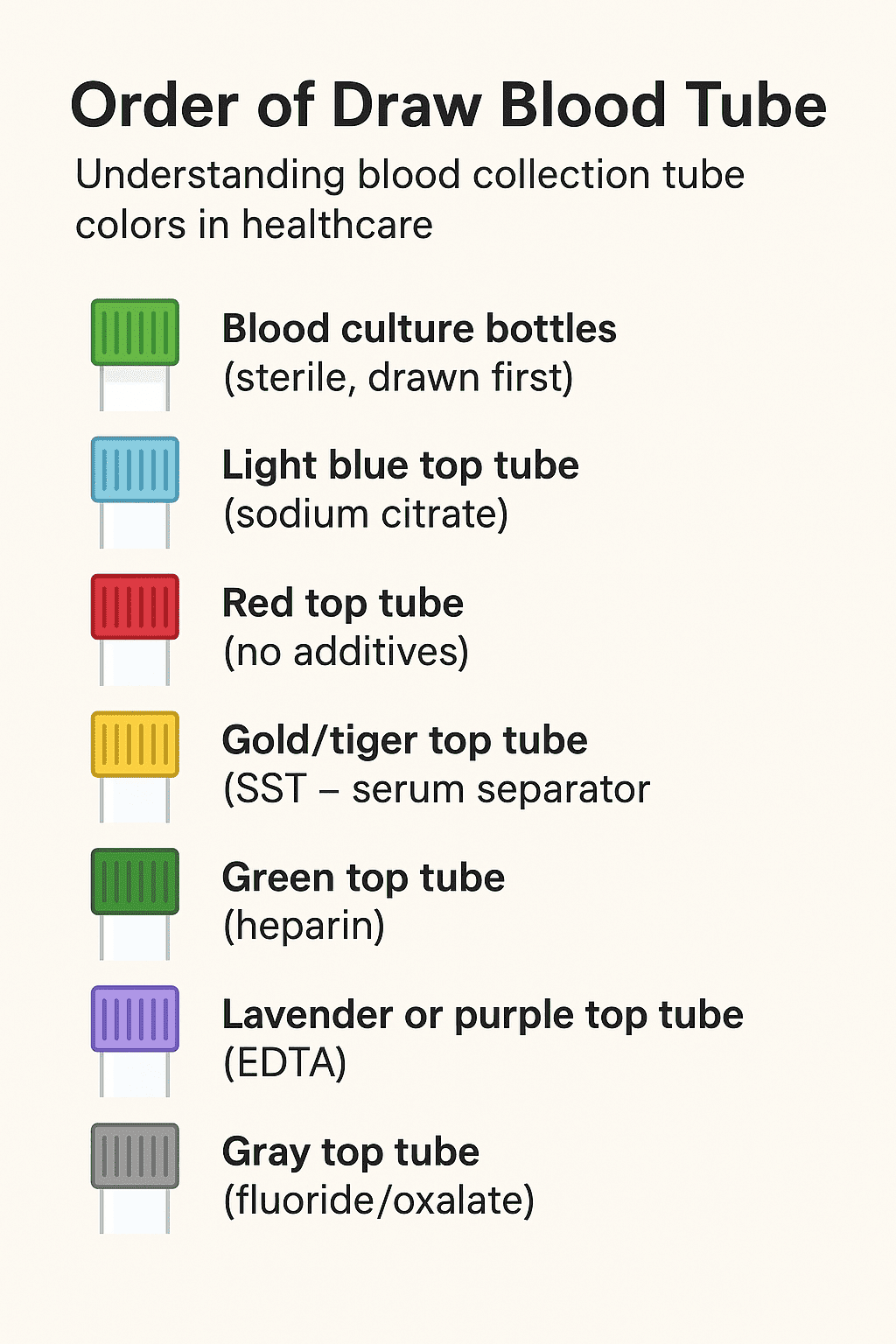
When someone goes to the doctor for blood work, it can look like a simple process. A tourniquet, a needle, and a few colorful tubes—that’s it, right? But behind those small tubes is a carefully designed system that helps doctors and nurses get the most accurate results. Each tube color has a purpose, and the order of draw in which they’re filled actually matters a lot.
This guide will walk through the order of draw for blood tubes, explain what each tube color means, and share why following the right steps keeps patients safe and results reliable.
Why the Order of Draw Matters
A lot of decisions in healthcare are based on blood tests, from finding diseases to changing medicines. The results might not be what they seem to be if blood is taken in the wrong way.
In phlebotomy, the order of draw is important because
- Prevents cross-contamination: Cross-contamination is avoided because each tube has its own chemicals, such as anticoagulants or preservatives. These chemicals can be moved to the next tube if they are drawn in the wrong order. This can change the test results.
- Keeps patients safe: doctors can make the right decisions about treatments when blood tests are accurate.
- Stays away from repeat sticks: Nobody likes being poked twice. If you do things the right way, you may not need another blood draw.
To compare, it’s like following the steps in a dish. If you change anything, the end result won’t be right.
The Standard Order of Draw
The order of draw blood collection tubes is standardized so that healthcare professionals around the world follow the same process. The order usually goes like this:
- Blood culture bottles (sterile, drawn first)
- Light blue top tube (sodium citrate)
- Red top tube (no additives)
- Gold/tiger top tube (SST – serum separator)
- Green top tube (heparin)
- Lavender or purple top tube (EDTA)
- Gray top tube (fluoride/oxalate)
Let’s look at each tube color more closely.

1. Blood Culture Bottles – First in the Order
What They Are
Blood culture bottles are usually clear or have a colored cap like yellow, green, or purple. They are drawn first to make sure the sample is not contaminated by additives from other tubes.
Why They’re Important
They’re used to detect infections in the blood, such as sepsis. Since sterility is critical, these must always be collected before other tubes.
2. Light blue top tube
Additive Inside
Has sodium citrate in it, which stops blood from clotting.
What It’s For
Tests for coagulation, such as PT, INR, and aPTT
Tests to assess how successfully blood clots
Why the Order Matters
It might change the clotting times if a different additive is mixed in, which would give you false findings. That’s why bright blue is toward the start of the list.
3. Red Top Tube (Plain)
Additive Inside
No additive, just a plain tube. Sometimes, a gold top or tiger top (SST) is used, which has a gel to separate serum.
What It’s Used For
- Chemistry tests
- Serology
- Blood bank testing
Key Point
Since this tube doesn’t have additives, it provides a “clean” sample of serum.
4. Gold or Tiger Top Tube (SST)
Additive Inside
Serum separator with clot activator.
What It’s Used For
- Chemistry panels
- Hormone levels
- Lipid panels
Key Point
The gel forms a barrier between serum and blood cells after spinning in a centrifuge, making it easy for labs to test serum.
5. Green Top Tube
Additive Inside
Contains heparin (either lithium or sodium).
What It’s Used For
- Chemistry tests needing plasma
- Electrolyte levels
- Ammonia levels
Why It’s Placed Here
If drawn before serum tubes, heparin could affect results in plain or gel tubes.
6. Lavender or Purple Top Tube
Additive Inside
Contains EDTA, which binds calcium and prevents clotting.
What It’s Used For
- Complete blood count (CBC)
- Hemoglobin A1C (for diabetes)
- Blood typing
Key Point
This is one of the most common tubes, especially in routine check-ups.
7. Gray Top Tube
Additive Inside
Contains potassium oxalate and sodium fluoride, which stop glycolysis (the breakdown of sugar).
What It’s Used For
- Glucose testing
- Blood alcohol levels
- Lactate testing
Why It’s Last
Since it has strong additives, it can interfere with most other tests if drawn too early.
Remembering the Order of Draw for Blood Tube
For students, phlebotomists, and even experienced nurses, remembering the order of blood tube draw can be tricky. That’s why many people use memory tricks.
One popular mnemonic is:
Begin Lab Results Giving Logical, Lasting Guidance.
- B = Begin → Blood cultures
- L = Lab → Light Blue
- R = Results → Red
- G = Giving → Gold (SST)
- L = Logical → Light Green
- L = Lasting → Lavender
- G = Guidance → Gray
This makes the order easy to recall, even in a busy clinic.
Tips for Safe and Accurate Blood Collection
Use the right technique
Always follow infection control procedures, such as hand hygiene, gloves, and thorough site cleaning.
Invert the tubes gently
Each tube must be combined with its addition. But shaking might harm blood cells, so mild inversion is preferable.
Label immediately
Tubes should be labeled in front of the patient to minimize confusion.
Check for patient comfort
Explain what’s going on, use the smallest gauge needle possible, and ensure patients are comfortable.
Common Mistakes with Tube Order
Even experienced healthcare workers can sometimes make mistakes. Some common ones include:
- Drawing tubes in the wrong order – leading to contaminated results
- Underfilling tubes – which can throw off the additive-to-blood ratio
- Forgetting to invert – causing clotting in tubes that need mixing
The good news is that knowing the proper order of draw for venipuncture prevents most of these problems.
Why Patients Should Care
While the order of draw may seem like a detail only phlebotomists need, patients benefit when it’s followed correctly. Proper technique means:
- More accurate results
- Fewer repeat blood draws
- Faster answers from the lab
So next time someone notices the different colored tubes, they’ll know those colors are more than just decoration—they’re part of keeping healthcare safe and effective.
Final Thoughts
The order in which you draw blood tube colors may seem like a tiny thing, but in healthcare, small things may make a big difference in a person’s life. Following this approach makes sure that test findings are still accurate, trustworthy, and relevant for diagnosis.
Healthcare personnel safeguard both the patient and the integrity of the laboratory process by knowing what each tube color indicates and following the right order.
 +86-791-8686-1216
+86-791-8686-1216 

